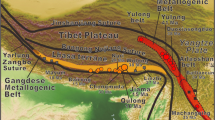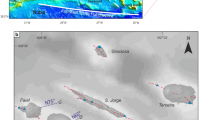Abstract
Carbonatites are believed to have crystallized either from mantle-derived primary carbonate magmas or from secondary melts derived from carbonated silicate magmas through liquid immiscibility or from residual melts of fractional crystallization of silicate magmas. Although the observed coexistence of carbonatites and alkaline silicate rocks in most complexes, their coeval emplacement in many, and overlapping initial87Sr/86Sr and143Nd/144Nd ratios are supportive of their cogenesis; there have been few efforts to devise a quantitative method to identify the magmatic processes. In the present study we have made an attempt to accomplish this by modeling the trace element contents of carbonatites and coeval alkaline silicate rocks of Amba Dongar complex, India. Trace element data suggest that the carbonatites and alkaline silicate rocks of this complex are products of fractional crystallization of two separate parental melts. Using the available silicate melt-carbonate melt partition coefficients for various trace elements, and the observed data from carbonatites, we have tried to simulate trace element distribution pattern for the parental silicate melt. The results of the modeling not only support the hypothesis of silicate-carbonate melt immiscibility for the evolution of Amba Dongar but also establish a procedure to test the above hypothesis in such complexes.
Similar content being viewed by others
References
Basu A R, Renne P R, Das Gupta D K, Teichman F and Poreda R J 1993 Early and late alkali igneous pulses and a high3He plume origin for the Deccan flood basalts;Science 261 902–906
Bell K 1989Carbonatites: Genesis and Evolution (London: Unwin Hyman)
Bell K and Tilton G R 2002 Probing the mantle: the story from carbonatites;EOS Trans. 83 273–277
Bevington P R, Robinson D K and Bevington P 2002Data Reduction and Error Analysis for the Physical Sciences, (New York: McGraw-Hill Science)
Dawson J B and Hinton R W 2003 Trace-element content and partitioning in calcite, dolomite and apatite in carbonatite, Phalaborwa, South Africa;Mineral. Mag. 67 921–930
Dawson J B, Smith J V and Steele I M 1994 Trace-element distribution between coexisting perovoskite, apatite and titanite from Oldoinyo Langai, Tanzania;Chem. Geol. 117 285–290
Dunworth E A and Bell K 2001 The Turiy Massif, Kola Peninsula, Russia: Isotopic and geochemical evidence for multi-source evolution;J. Petrol. 42 377–405
Gwalani L G, Rock N M S, Chang W-J, Fernandez S, Allègre C J and Prinzhofer A 1993 Alkaline rocks and carbonatites of Amba Dongar and adjacent areas, Deccan Igneous Province, Gujarat, India. 1. Geology, petrography and petrochemistry;Mineral. Petrol. 47 219–253
Hamilton D L, Bedson P, Esson J 1989 The behaviour of trace elements in the evolution of carbonatites. In:Carbonatites: Genesis and Evolution, (ed) K Bell (London: Unwin Hyman) 405–427
Harmer R E and Gittins J 1998 The case for primary, mantle-derived carbonatite magma;J. Petrol. 39 1895–1903
Iwata N 1997Geochronological study of the Deccan volcanism by 40Ar-39Armethod, Ph.D. thesis, Univ. Tokyo
Ionov D and Harmer R E 2002 Trace element distribution in calcite-dolomite carbonatites from Spitskop: inferences for differentiation of carbonatite magmas and the origin of carbonatites in mantle xenoliths;Earth Planet. Sci. Lett. 198 495–510
Jones J H, Walker D, Picket D A, Murrel M T and Beate P 1995 Experimental investigations of the partitioning of Nb, Mo, Ba, Ce, Pb, Ra, Th, Pa and U between immiscible carbonate and silicate liquids;Geochim. Cosmochim. Acta 59 1307–1320
Keller J and Spettel B 1995 The trace element composition and petrogenesis of natrocarbonatites. In:Carbonatite Volcanism: Oldoinyo Lengai and the Petrogenesis of Natrocarbonatites (eds) K Bell and J Keller (Springer) 70–86
Klemme S and Dalpé C 2003 Trace-element partitioning between apatite and carbonatite melt;Am. Mineral. 88 639–646
Klemme S and Meyer H-P 2003 Trace element partitioning between baddeleyite and carbonatite melt at high pressures and high temperatures;Chem. Geol. 199 233–242
Korobeinikov A N, Mitrofanov F P, Gehör S, Laajoki K, Pavlov V P and Mamontov V P 1998 Geology and copper sulphide mineralization of the Salmagorskii Ring Igneous Complex, Kola Peninsula, NW Russia;J. Petrol. 39 2033–2041
Laul J C 1979 Neutron activation analysis of geologic materials;Atm. Energy Rev. 17 603–695
LeBas M J 1989 Diversification of carbonatite. In:Carbonatites: Genesis and Evolution (ed) K Bell (London: Unwin Hyman) 428–445
Lee W J and Wyllie P J 1997 Liquid immiscibility in the join NaAlSiO4-NaSi3O8-CaCO3 at 1 Gpa: Implications for crustal carbonatites;J. Petrol. 98 1113–1135
Petibon C M, Kjarsgaard B A and Jenner G A 1998 Phase relationships of a silicate-bearing natrocarbonatite from Oldoinyo Lengai at 20 and 100 MPa;J. Petrol. 39 2137–2151
Ray J S 1998 Trace element and isotope evolution during concurrent assimilation, fractional crystallization and liquid immiscibility of a carbonated silicate magma;Geochim. Cosmochim. Acta 62 3301–3306
Ray J S and Pande K 1999 Carbonatite alkaline magmatism associated with continental flood basalts at stratigraphic boundaries: cause for mass extinctions;Geophys. Res. Lett. 26 1917–1920
Ray J S, Pande K, Pattanayak S K 2003 Evolution of Amba Dongar carbonatite complex: Constraints from40Ar-39Ar chronologies of the Inner Basalt and an alkaline plug;Int. Geo. Rev. 45 857–862
Ray J S, Pande K and Venkatesan T R 2000a Emplacement of Amba Dongar carbonatite-alkaline complex at Cretaceous/Tertiary boundary from40Ar-39Ar chronology;Proc. Indian Acad. Sci. (Earth Planet. Sci.) 109 39–47
Ray J S and Ramesh R 1999 Evolution of carbonatite complexes of Deccan flood basalt province, India: Stable carbon and oxygen isotopic constraints;J. Geophys. Res. 104 29471–29482
Ray J S, Trivedi J R, Dayal A M 2000b Strontium isotope systematics of Amba Dongar and Sung Valley carbonatite-alkaline complexes, India: evidence for liquid immiscibility, crustal contamination and long-lived Rb/Sr enriched mantle sources;J. Asian Earth Sci. 18 585–594
Simonetti A, Bell K and Viladkar S G 1995 Isotopic data from the Amba Dongar carbonatite complex west-central India: Evidence for an enriched mantle source;Chem. Geol. (Isot. Geosci.) 122 185–198
Srivastava R K 1997 Petrology, petrochemistry and genesis of rift-related carbonatites of Ambadungar, India;Miner. Petrol. 61 47–66
Sun S -s and McDonough W F 1989 Chemical and isotopic systematics of oceanic basalts: implications for mantle composition and processes; In:Magmatism in the Ocean Basins, (eds) A D Saunders and M J NorryGeol. Soc. Spl. Pub. 42 313–345
Sweeney R J 1994 Carbonatite melt compositions in the Earth's mantle;Earth Planet. Sci. Lett. 128 259–270
Veksler I V, Nielsen T F D and Sokolov S V 1998a Mineralogy of crystallized melt inclusions from Gardiner and Kovdor ultramafic alkaline complexes: Implications for carbonatite genesis;J. Petrol. 39 2015–2031
Veksler IV, Petibon C, Jenner G A, Dorfman AM and Ding-well D B 1998b Trace element partitioning in immiscible silicate-carbonate liquid systems: an initial experimental study using a centrifuge autoclave;J Petrol 39 2095–2104
Viladkar S G 1996Geology of the carbonatite-alkalic dia-treme of Amba Dongar, Gujarat. A monograph published by GMDC, Ahmedabad
Viladkar S G and Dulski P 1986 Rare earth element abundances in carbonatites, alkaline rocks and fenites of Ambadungar, Gujarat, India;N. Jb. Miner Mh. H1 37–48
Viladkar S G and Wimmenauer W 1992 Geochemical and petrological studies on the Amba Dongar carbonatites (Gujarat, India);Chem. Erde 52 277–291
Wendlandt R F and Harrison W J 1979 Rare earth element partitioning between immiscible carbonate and silicate liquids and CO2 vapor: Results and implications for the formation of light rare earth enriched rock;Contrib. Mineral. Petrol. 29 242–254
Williams-Jones A E and Palmer D A S 2002 The evolution of aqueous-carbonic fluids in the Amba Dongar carbonatites, India: implications for fenitization;Chem. Geol. 185 283–301
Woolley A R and Kemp D R C 1989 Carbonatites: nomenclature, average chemical compositions and element distribution; In:Carbonatites: Genesis and Evolution, (ed) K Bell (London: Unwin Hyman) 1–14
Author information
Authors and Affiliations
Rights and permissions
About this article
Cite this article
Ray, J.S., Shukla, P.N. Trace element geochemistry of Amba Dongar carbonatite complex, India: Evidence for fractional crystallization and silicate-carbonate melt immiscibility. J Earth Syst Sci 113, 519–531 (2004). https://doi.org/10.1007/BF02704020
Issue Date:
DOI: https://doi.org/10.1007/BF02704020




